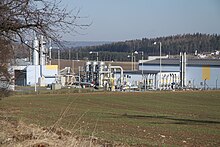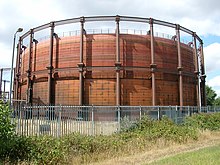
Natural gas is a naturally occurring mixture of gaseous hydrocarbons consisting primarily of methane (97%) in addition to various smaller amounts of other higher alkanes. Low levels of trace gases like carbon dioxide, nitrogen, hydrogen sulfide, and helium are also usually present. Methane is colorless and odorless, and the second largest greenhouse gas contributor to global climate change after carbon dioxide. Because natural gas is odorless, odorizers such as mercaptan are commonly added to it for safety so that leaks can be readily detected.

The Federal Energy Regulatory Commission (FERC) is an independent agency of the United States government that regulates the interstate transmission and wholesale sale of electricity and natural gas and regulates the prices of interstate transport of petroleum by pipeline. FERC also reviews proposals to build interstate natural gas pipelines, natural gas storage projects, and liquefied natural gas (LNG) terminals, in addition to licensing non-federal hydropower projects.

Compressed-air energy storage (CAES) is a way to store energy for later use using compressed air. At a utility scale, energy generated during periods of low demand can be released during peak load periods.

Coalbed methane, coalbed gas, or coal seam gas (CSG) is a form of natural gas extracted from coal beds. In recent decades it has become an important source of energy in United States, Canada, Australia, and other countries.

Liquefied natural gas (LNG) is natural gas (predominantly methane, CH4, with some mixture of ethane, C2H6) that has been cooled down to liquid form for ease and safety of non-pressurized storage or transport. It takes up about 1/600th the volume of natural gas in the gaseous state at standard conditions for temperature and pressure.

Natural gas prices, as with other commodity prices, are mainly driven by supply and demand fundamentals. However, natural gas prices may also be linked to the price of crude oil and petroleum products, especially in continental Europe. Natural gas prices in the US had historically followed oil prices, but in the recent years, it has decoupled from oil and is now trending somewhat with coal prices.

Southern Company Gas, formerly AGL Resources, is an American Fortune 500 energy services holding company headquartered in Atlanta, Georgia. The company's operations consist of natural gas distribution, wholesale services, retail operations, and midstream operations. Southern Company Gas is one of the largest natural gas distribution companies in the United States. The company serves approximately 4.5 million utility customers through its regulated distribution subsidiaries across four states. Southern Company Gas made the Fortune 500 list in 2015, Forbes 2000 in 2006, and is a member of the S&P 500 Index. In 2016, Southern Company acquired AGL Resources and renamed it Southern Company Gas.

Canada's natural gas liquids industry dates back to the discovery of wet natural gas at Turner Valley, Alberta in 1914. The gas was less important than the natural gasoline - "skunk gas" it was called, because of its distinctive odour - that early producers extracted from it. That natural gas liquid (NGL) could be poured directly into an automobile's fuel tank.

Cove Point LNG Terminal is an offshore liquid natural gas shipping terminal operated by BHE GT&S, a Berkshire Hathaway Energy company. It is located near Lusby, Maryland, United States, on the western shore of the Chesapeake Bay, and exports liquefied natural gas (LNG) and also stores gas. LNG is exported on specially designed ships known as LNG carriers.

Rough is a natural gas storage facility under the North Sea off the east coast of England. It is capable of storing 100 billion cubic feet of gas, nearly double the storage capacities in operation in Great Britain in 2021.

RAG Austria AG (RAG) is the largest gas storage operator and thus energy storage company in Austria. The company focuses its business activities on the storage of natural gas and other gaseous energy and the development of green-gas technologies. With a total storage capacity of more than six billion cubic meters of natural gas, RAG contributes to the security of supply of Austria and Central Europe. RAG operates the Haidach gas storage facility in joint ventures with Gazprom Export and Wingas as well as the 7Fields gas storage facility together with Uniper. In addition RAG operates its own storage facilities at Puchkirchen/Haag, Haidach 5, Aigelsbrunn, 7Fields(RAG). The production and use of gas as fuel are also business areas of RAG.
The United Kingdom's National Transmission System (NTS) is the network of gas pipelines that supply gas to about forty power stations and large industrial users from natural gas terminals situated on the coast, and to gas distribution companies that supply commercial and domestic users. It covers Great Britain, i.e. England, Wales and Scotland.

Haidach gas storage is an underground natural gas storage in the town of Haidach near Salzburg, Austria. As of the end of 2018 with a capacity of ~2.9 billion cubic meters (bcm) it is the third largest gas storage facility in Central Europe.

Natural gas was the United States' largest source of energy production in 2016, representing 33 percent of all energy produced in the country. Natural gas has been the largest source of electrical generation in the United States since July 2015.
Grain LNG Terminal is a Liquefied Natural Gas (LNG) terminal on the Isle of Grain, 37 miles (60 km) east of London. It has facilities for the offloading and reloading of LNG from ships at two jetties on the River Medway; for storing and blending LNG; for truck loading; and regasifying and blending natural gas to meet UK specifications. The terminal can handle up to 15 million tonnes per annum of LNG, has storage capacity for one million cubic metres of LNG, and is able to regasify up to 645 GWh per day for delivery into the high pressure gas National Transmission System (NTS). The facility is owned and operated by National Grid Grain LNG Ltd, a wholly owned subsidiary of National Grid.
Lake Tuz Natural Gas Storage is an underground natural gas storage facility under construction in Aksaray Province, central Turkey. It was developed artificially in a salt formation.
Jackson Prairie Underground Natural Gas Storage Facility is a natural gas storage facility in Southwest Washington, owned by Puget Sound Energy, Avista and Williams Companies's Northwest Pipeline GP. With 25 billion cubic feet working capacity, it is the largest natural gas-storage reservoir in the Pacific Northwest and the 14th largest in the United States.
The Iona Gas Plant is a natural gas processing and underground storage facility at Waarre near Port Campbell in the Australian state of Victoria. The Iona Gas Plant is owned by Lochard Energy.
A Strategic natural gas reserve is a government funded natural gas storage facility that holds long term stock piles of natural gas as compressed natural gas or liquefied natural gas in case of an emergency. After the 2021–2023 global energy crisis, there has been several countries in East Asia and India that have signaled a commitment to building national strategic natural gas reserves such as Japan, Taiwan, South Korea, and China.
Geostock is a French engineering company founded in 1965, and part of the Vinci Construction group. It specializes in underground energy storage. The company also has subsidiaries outside France.




















